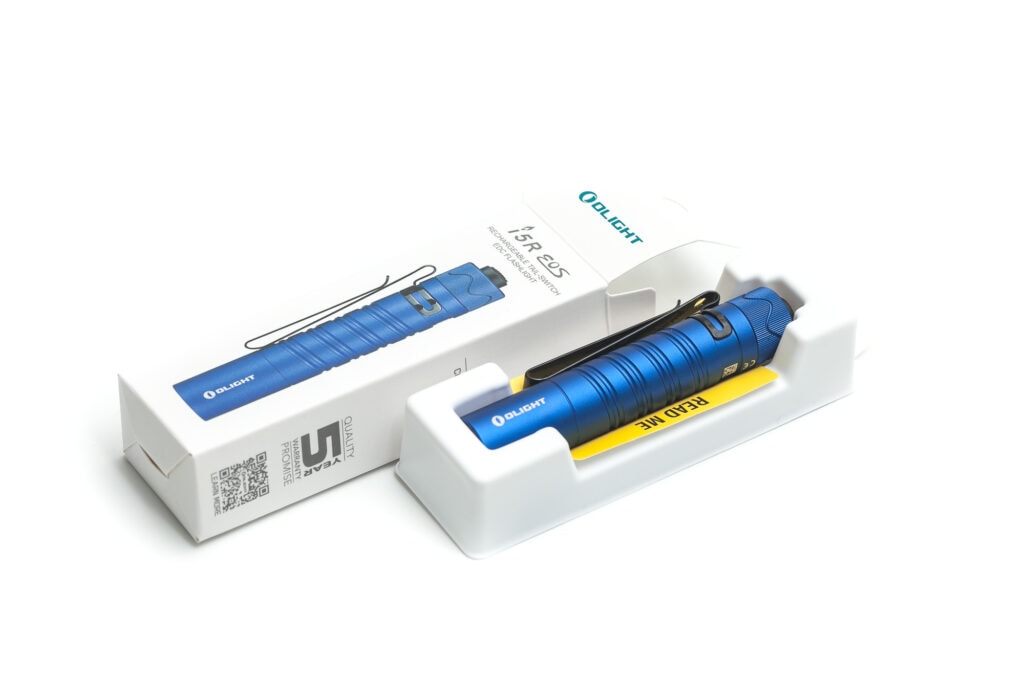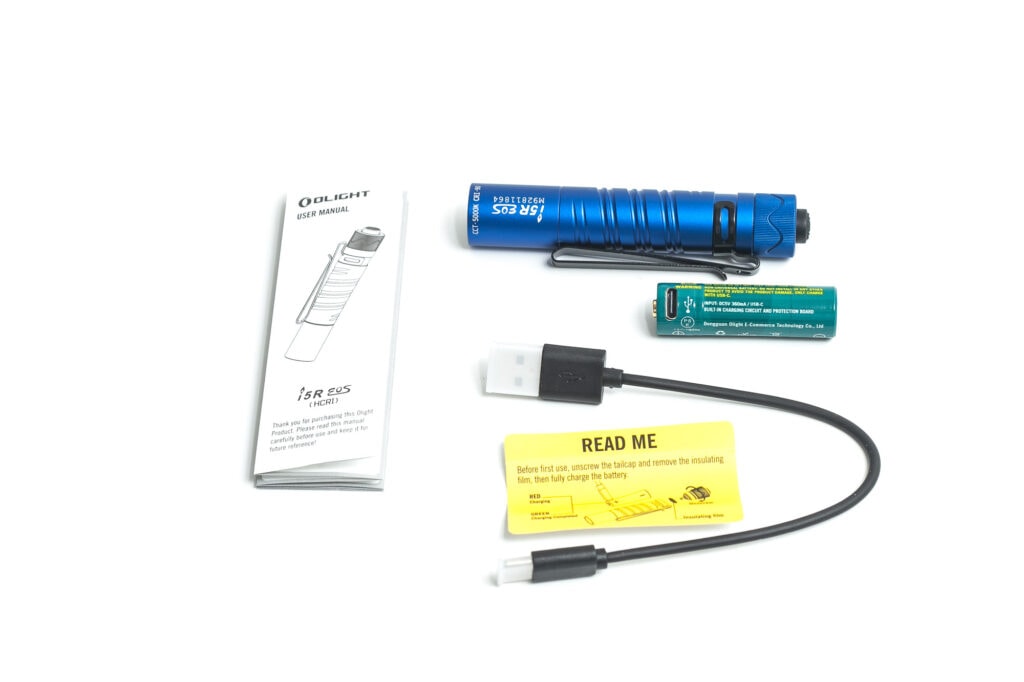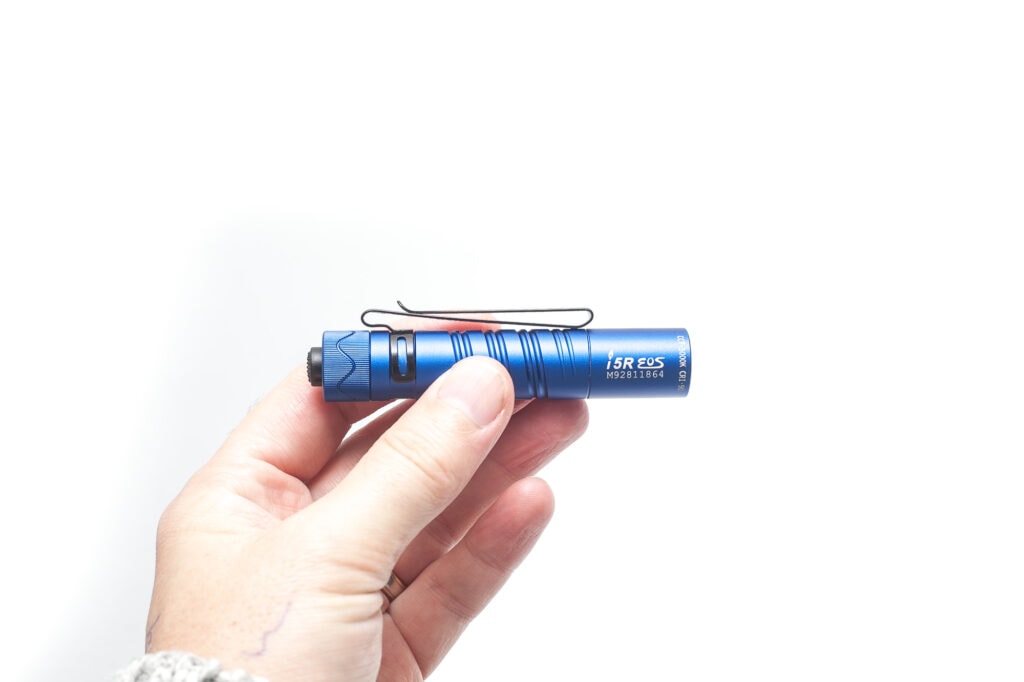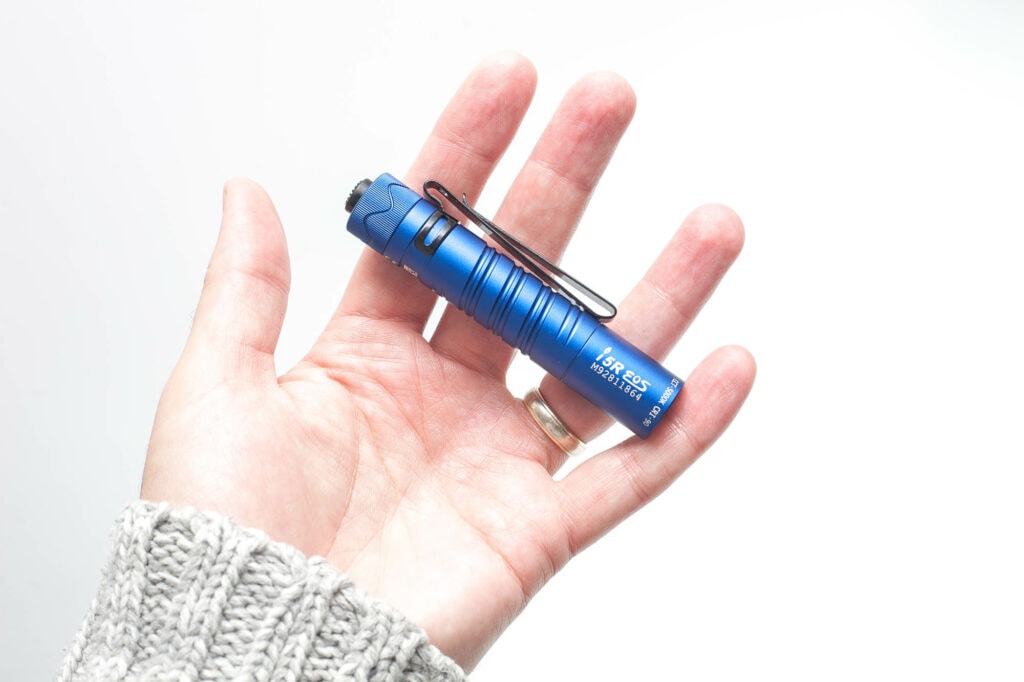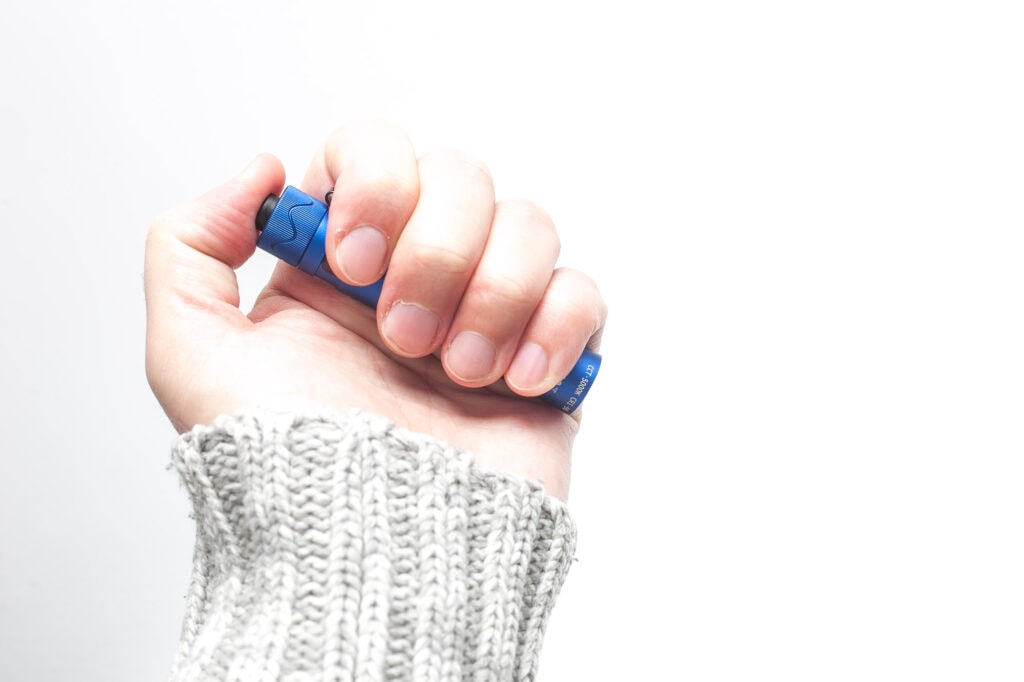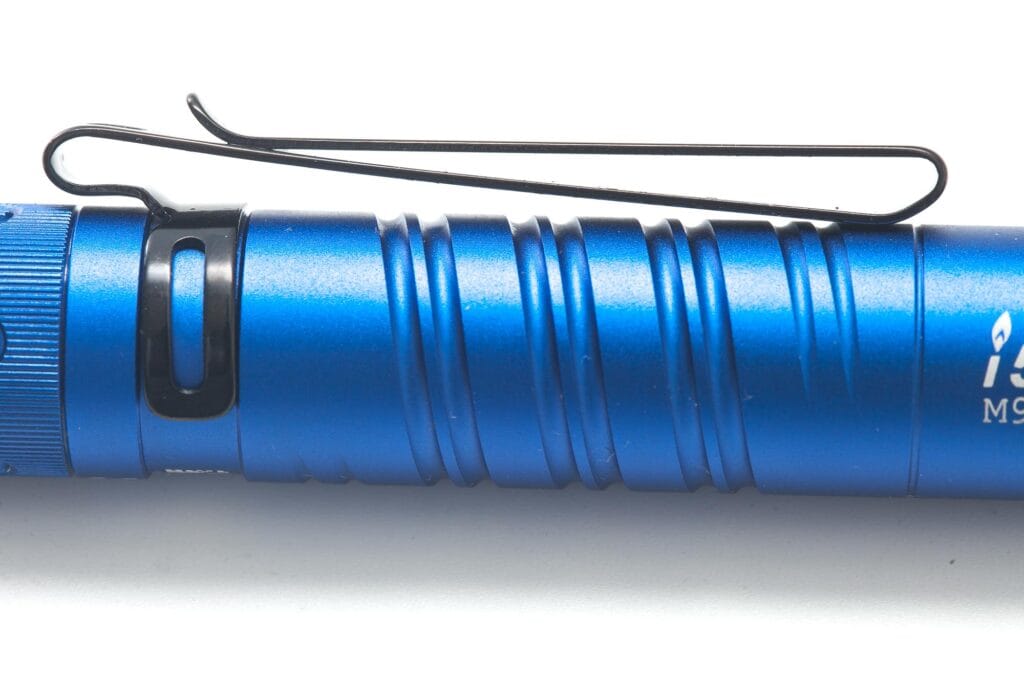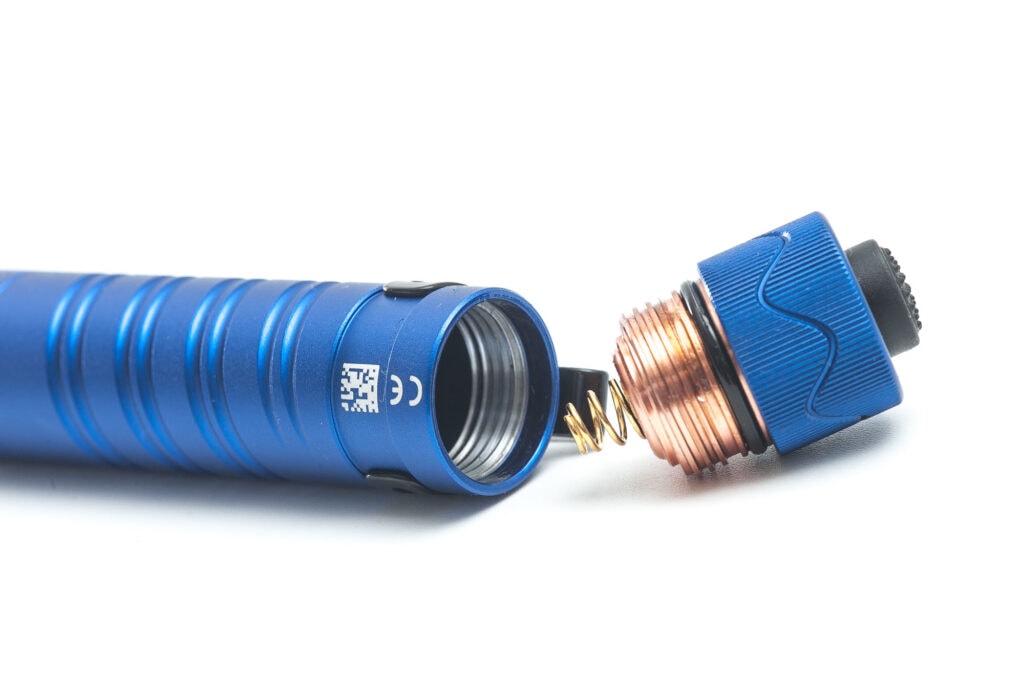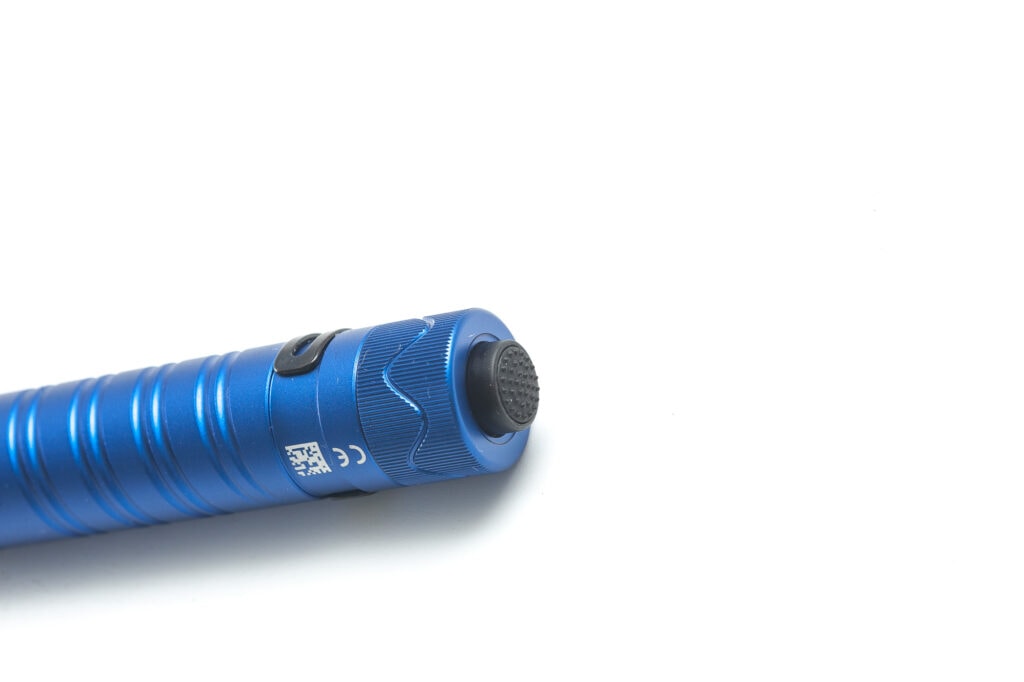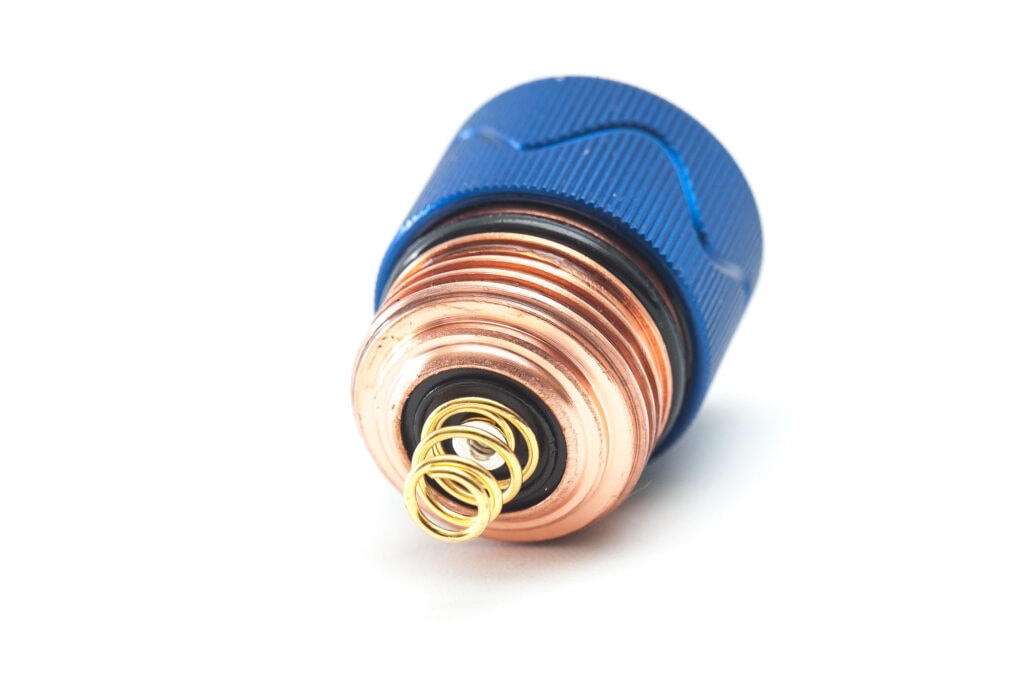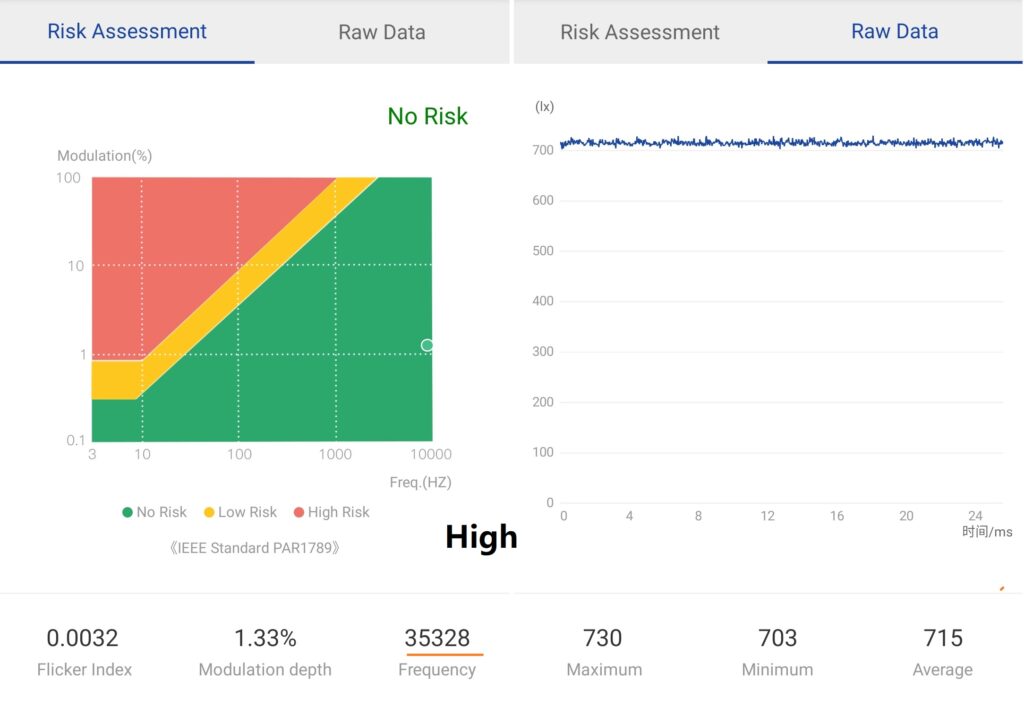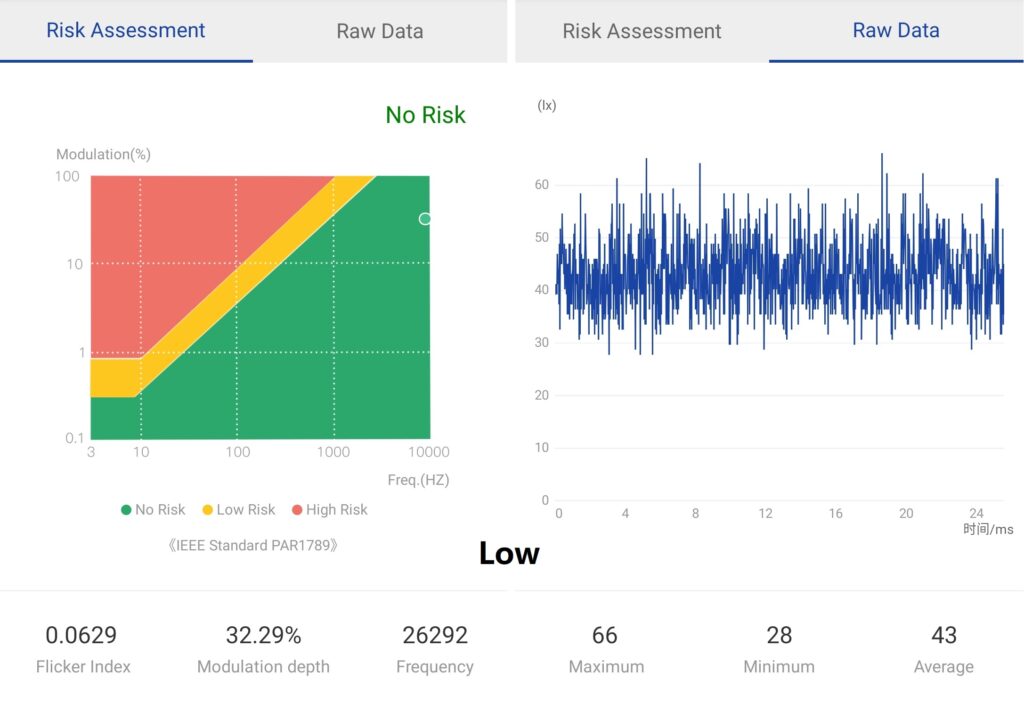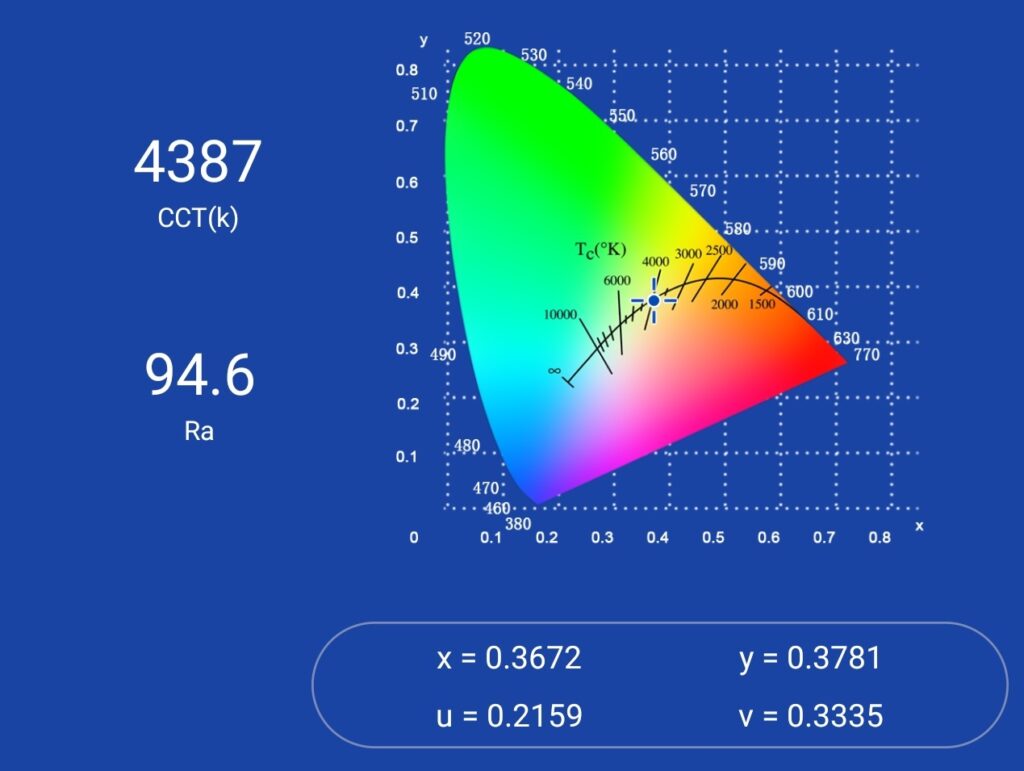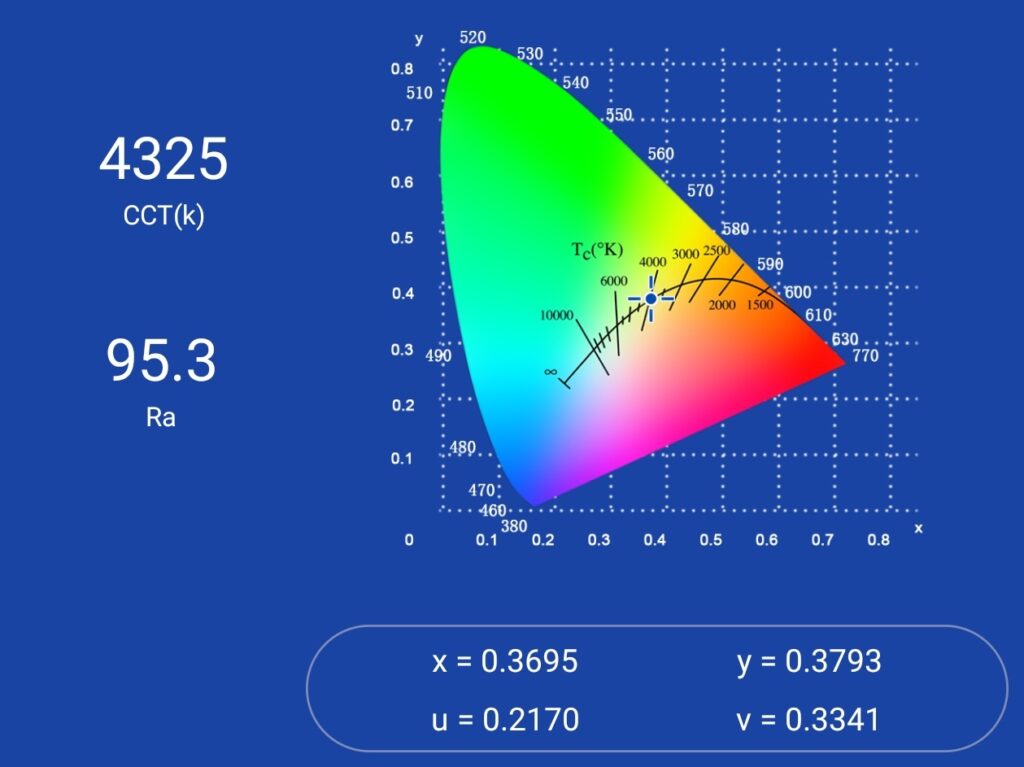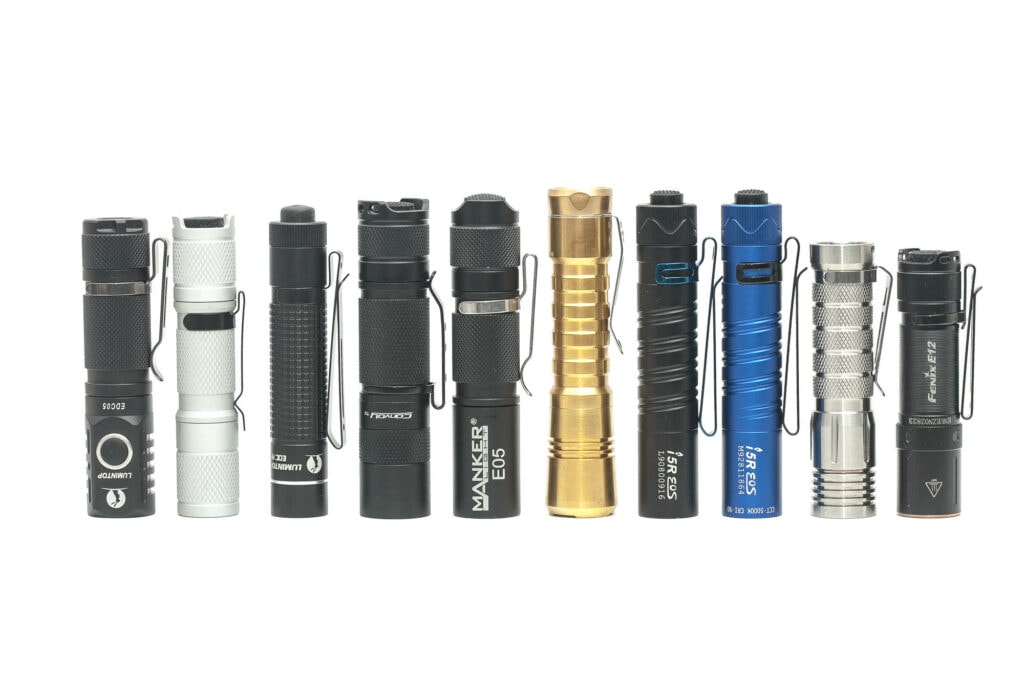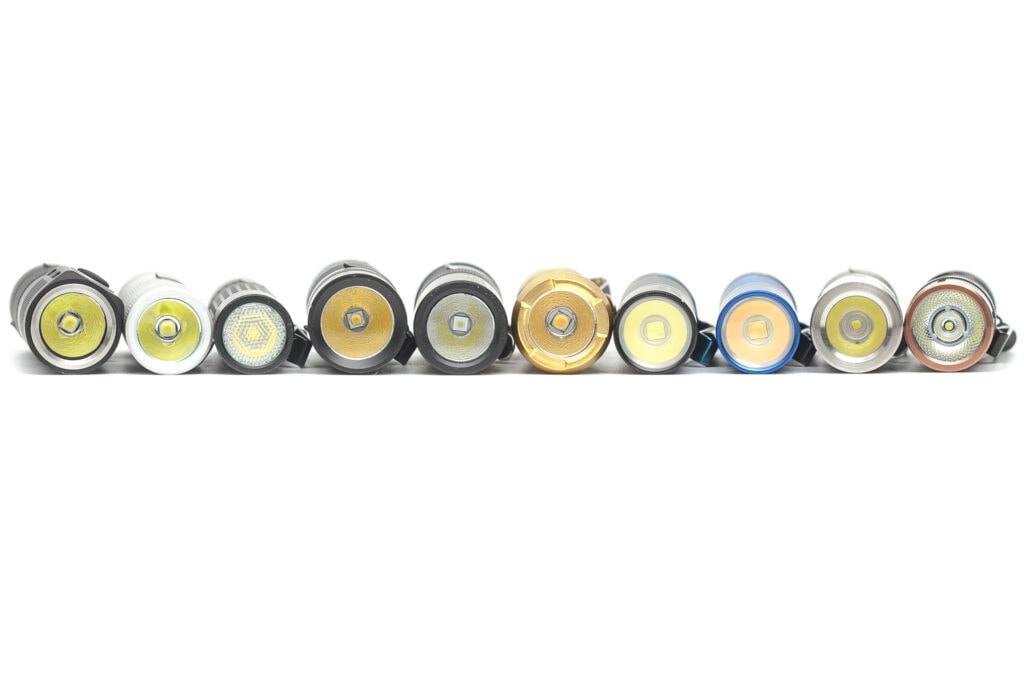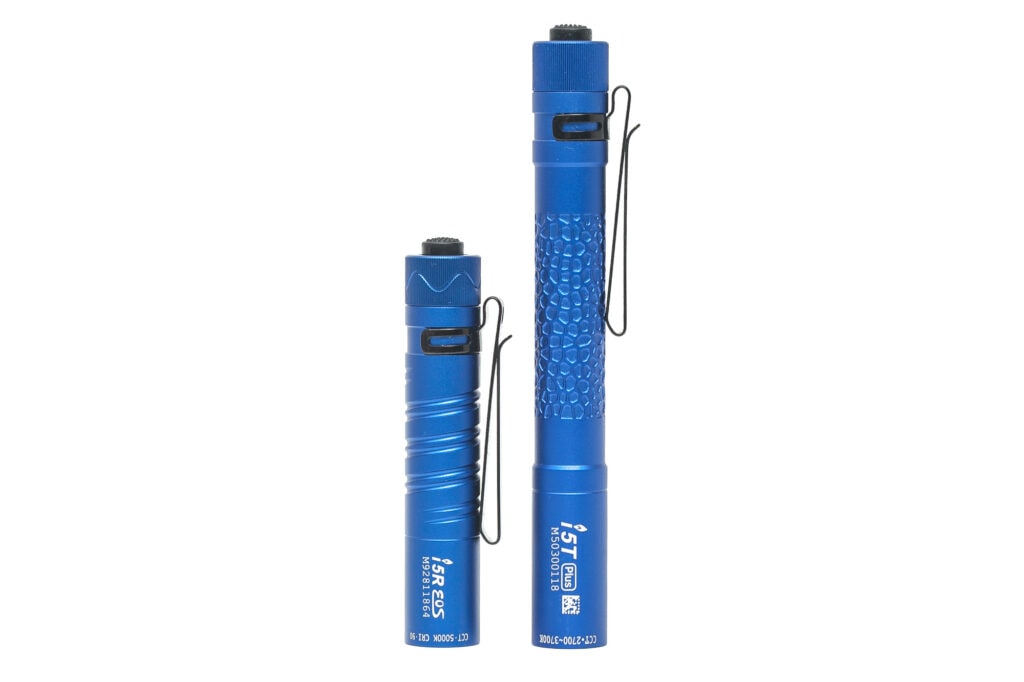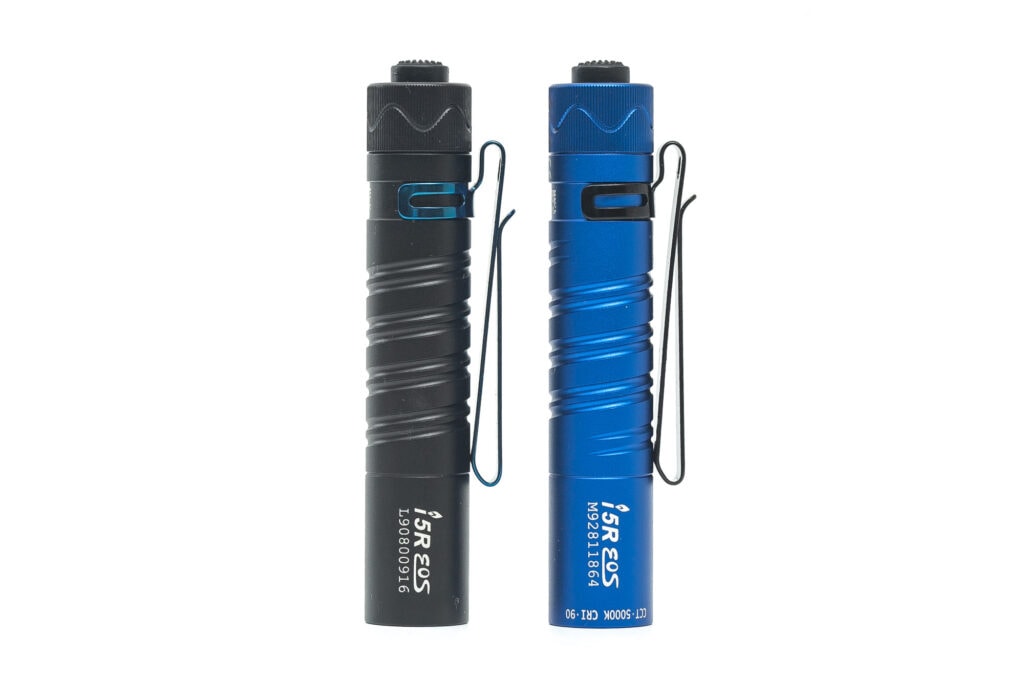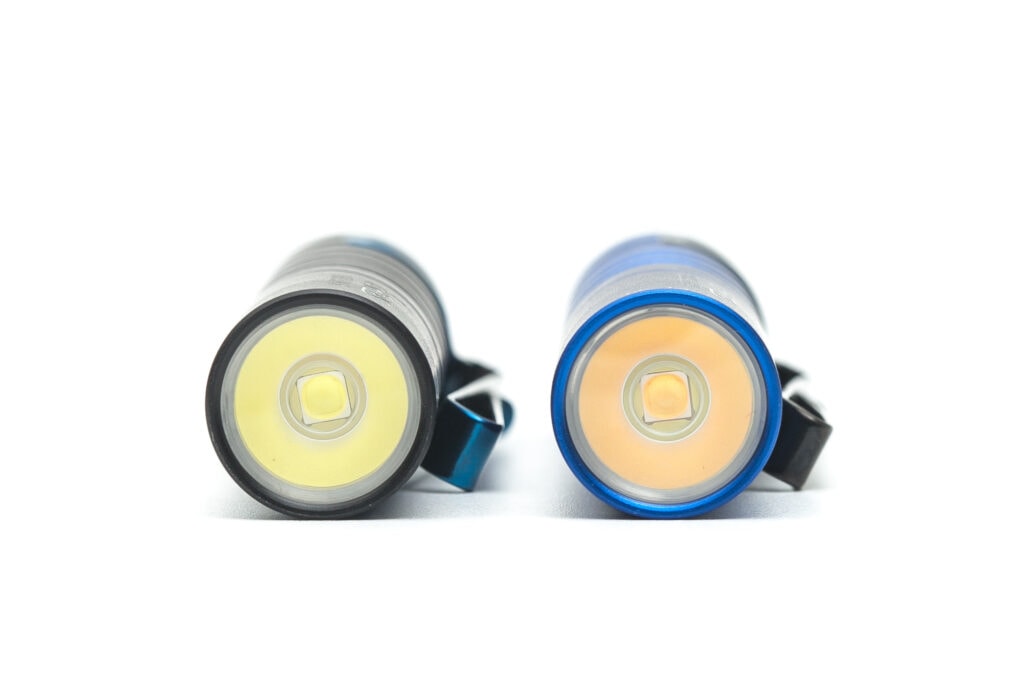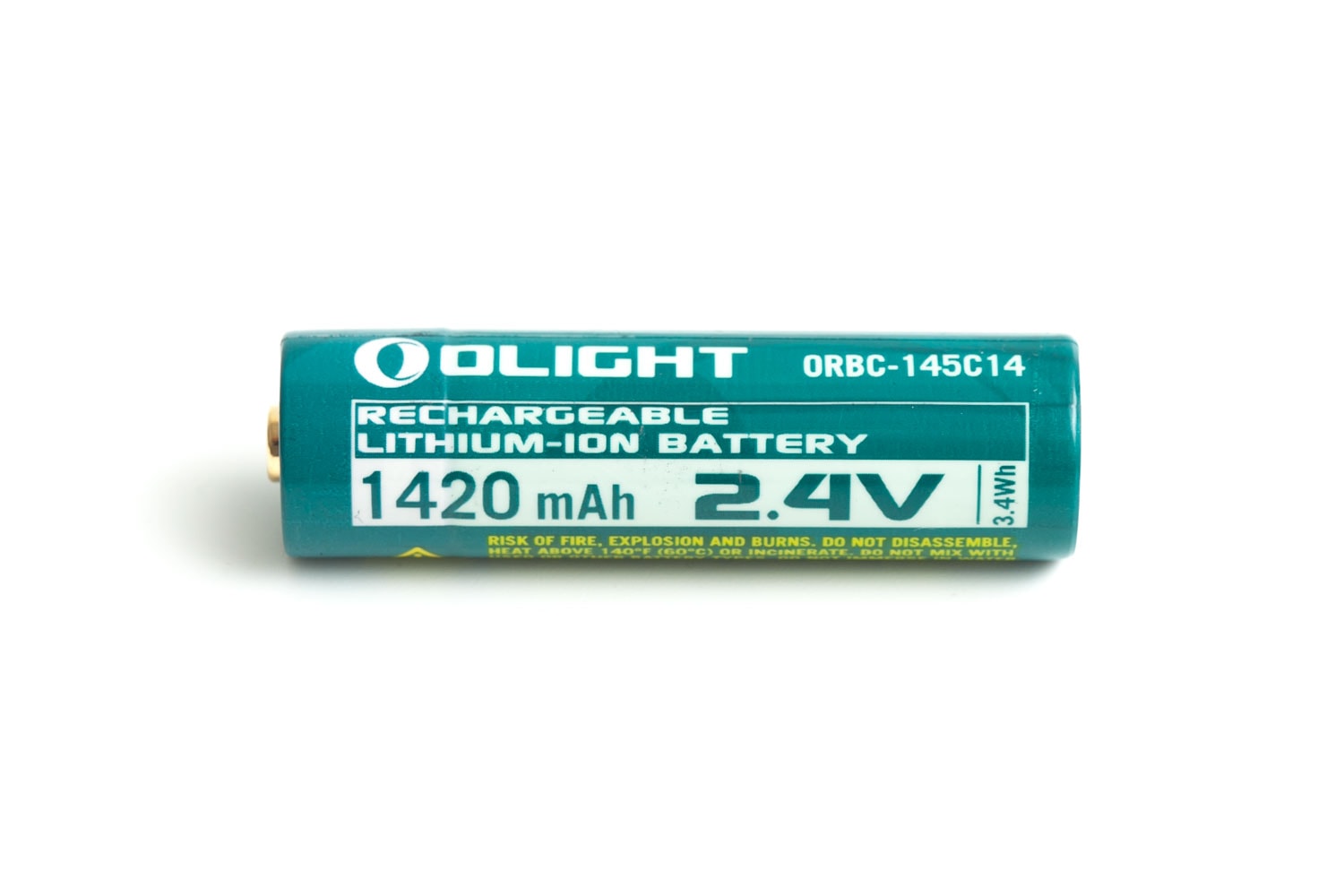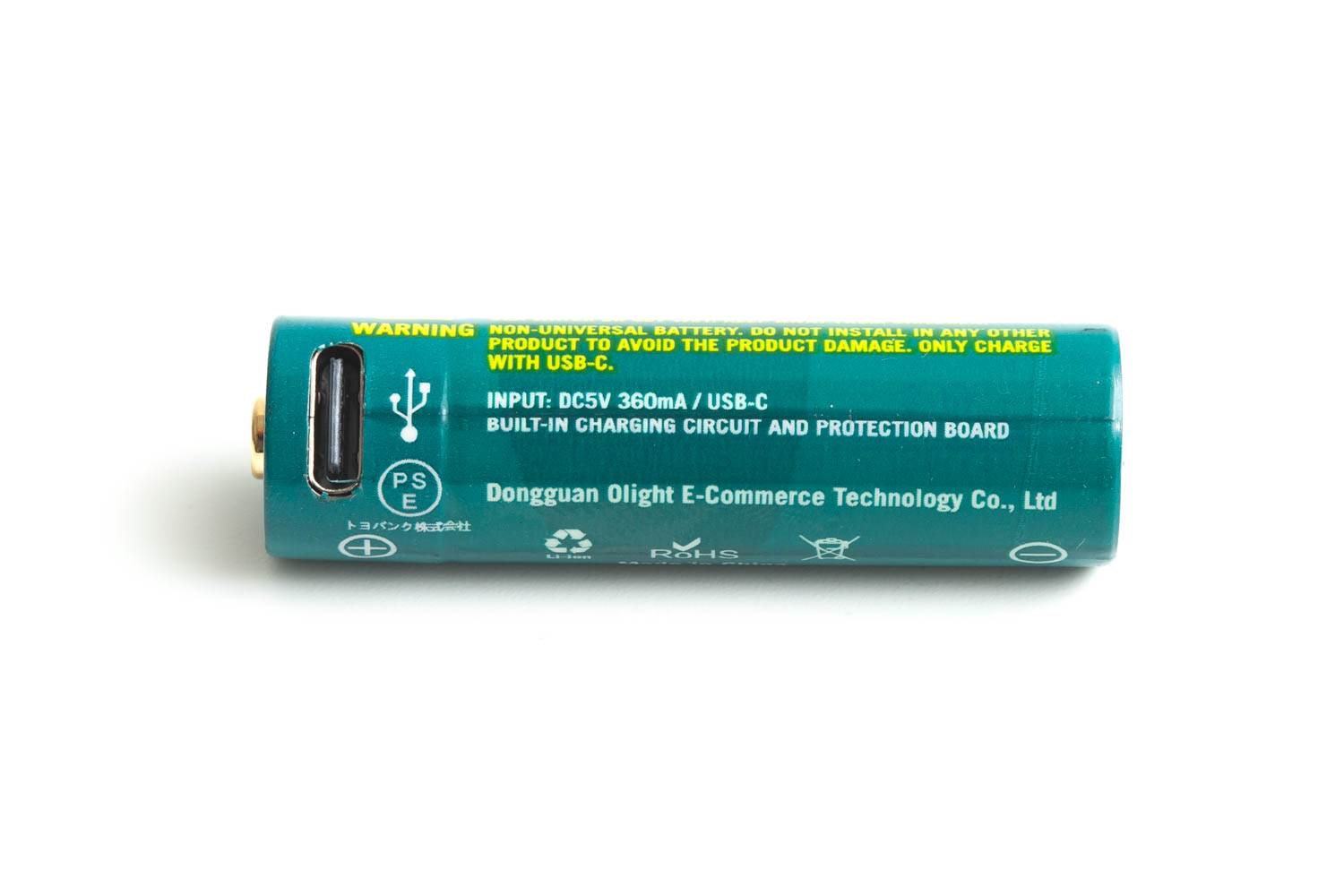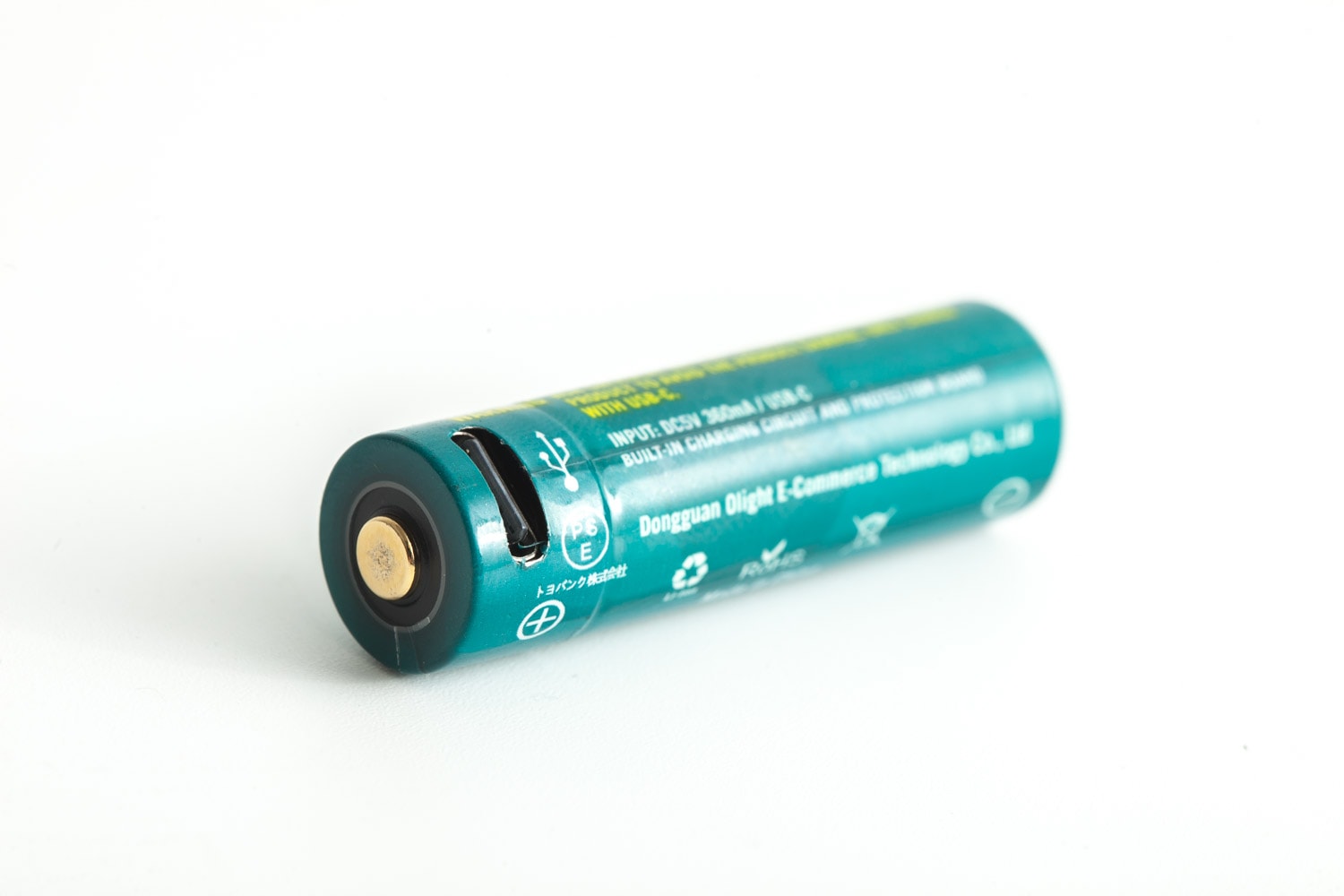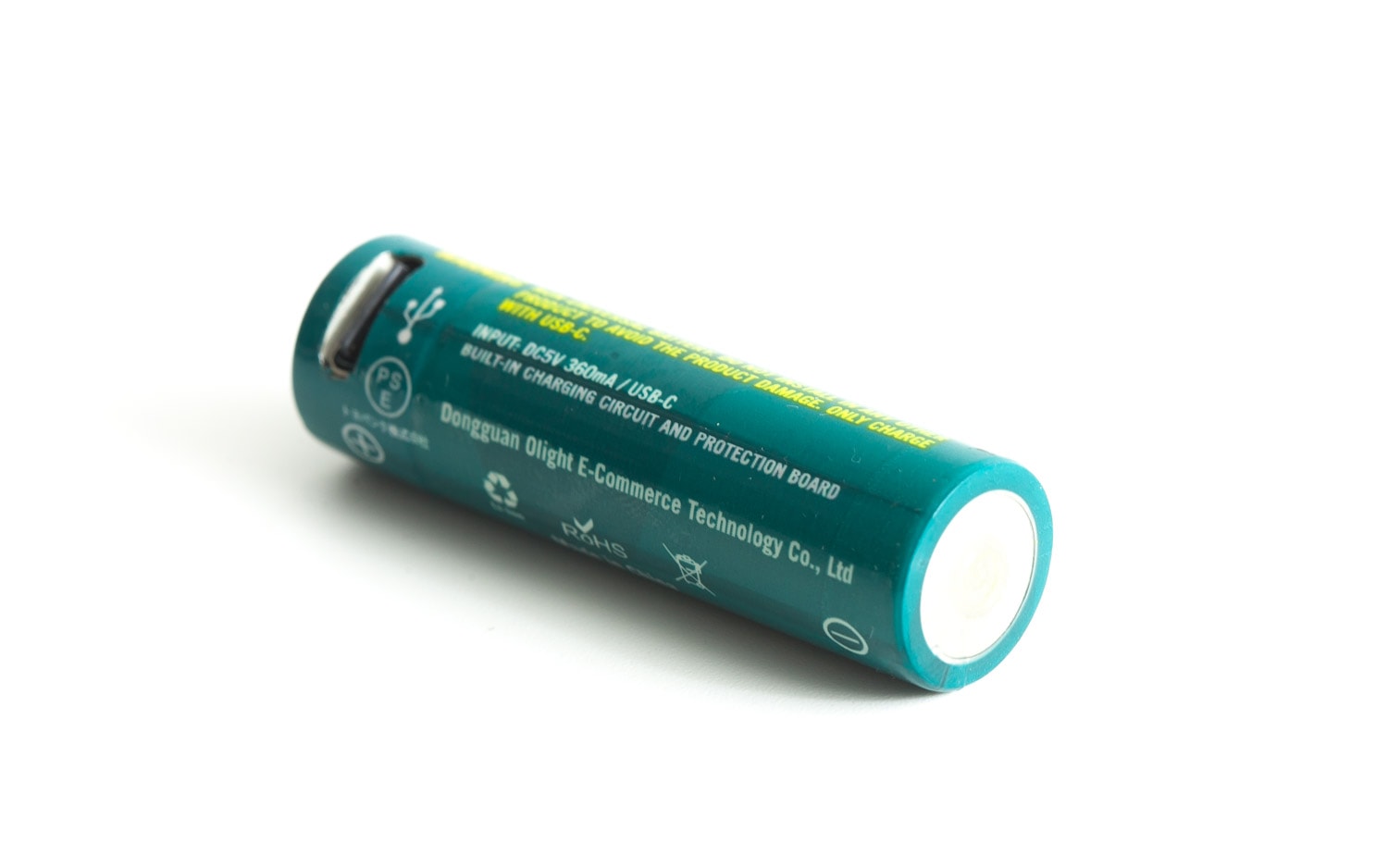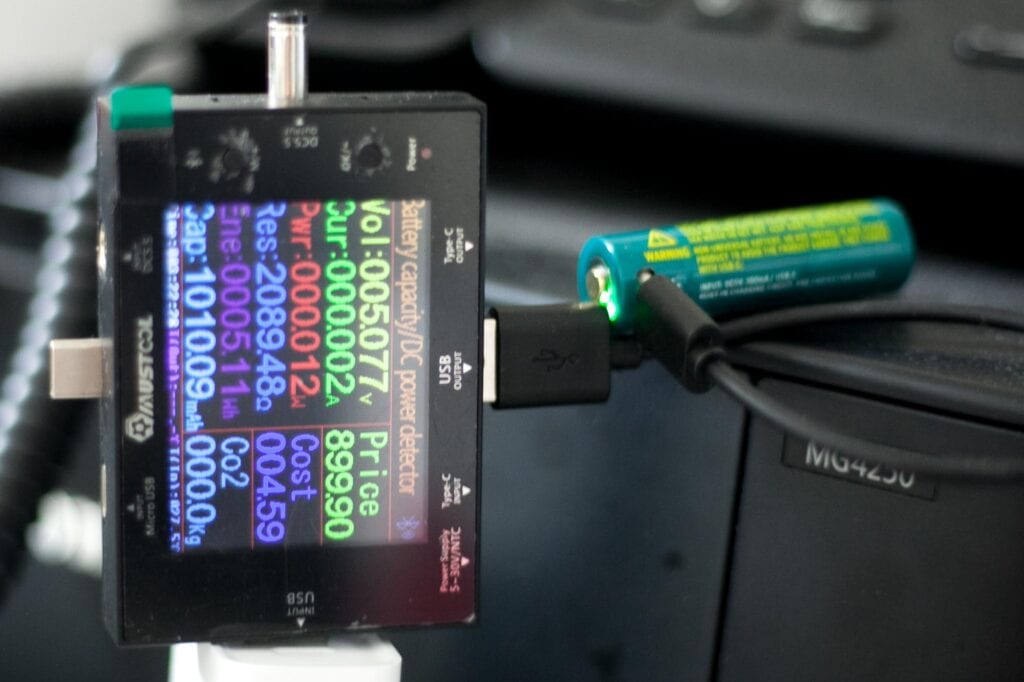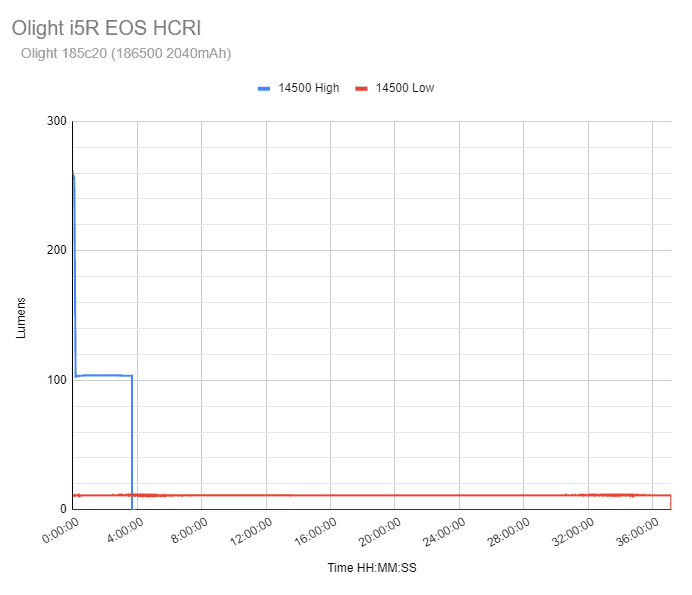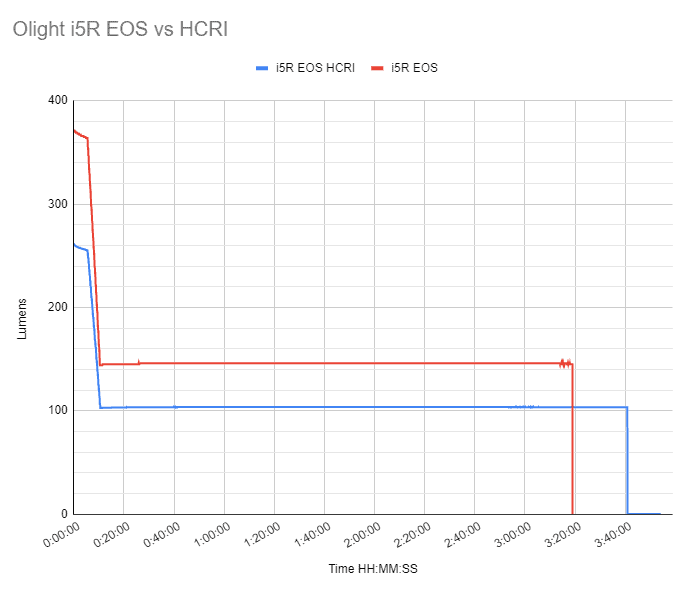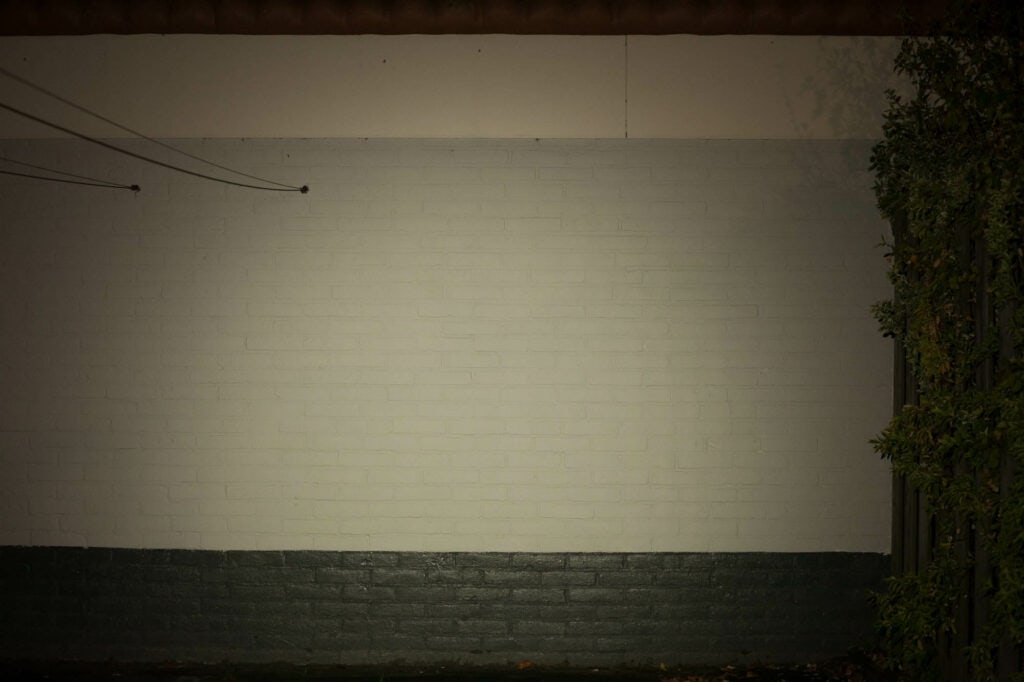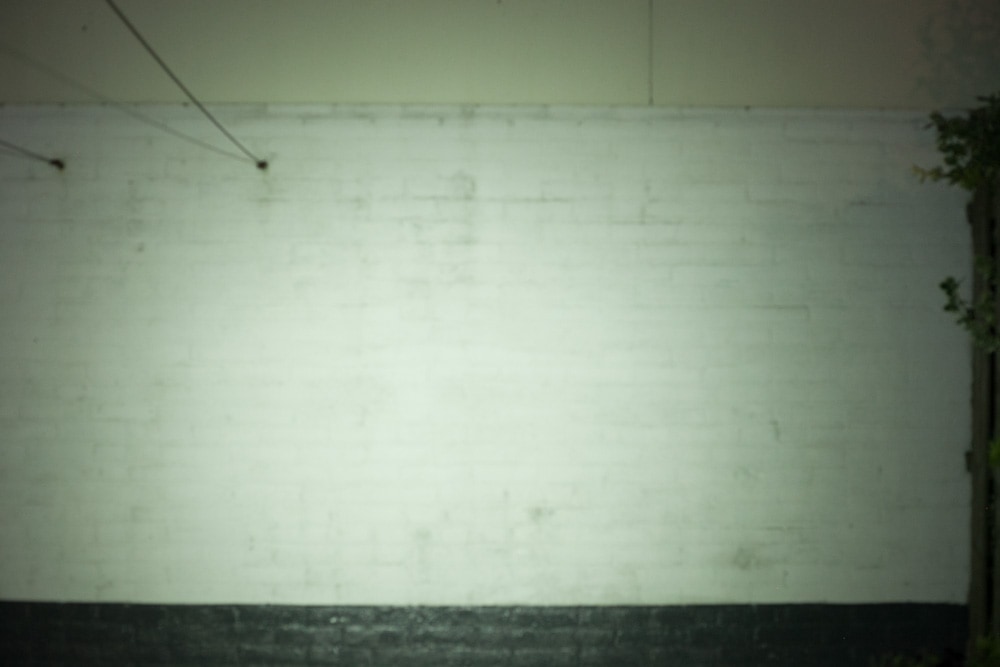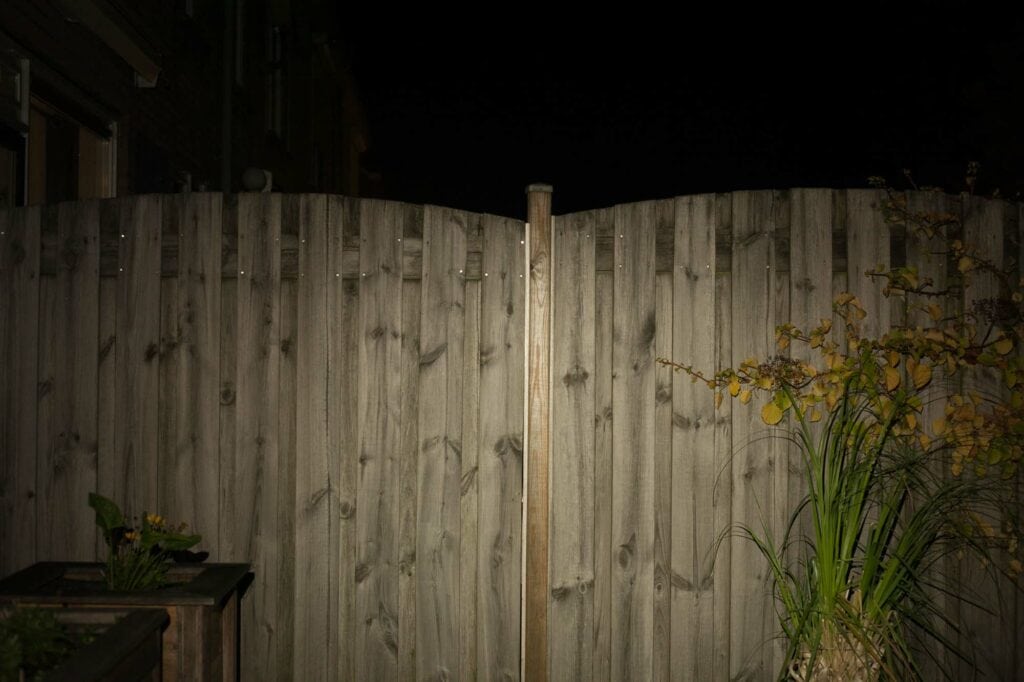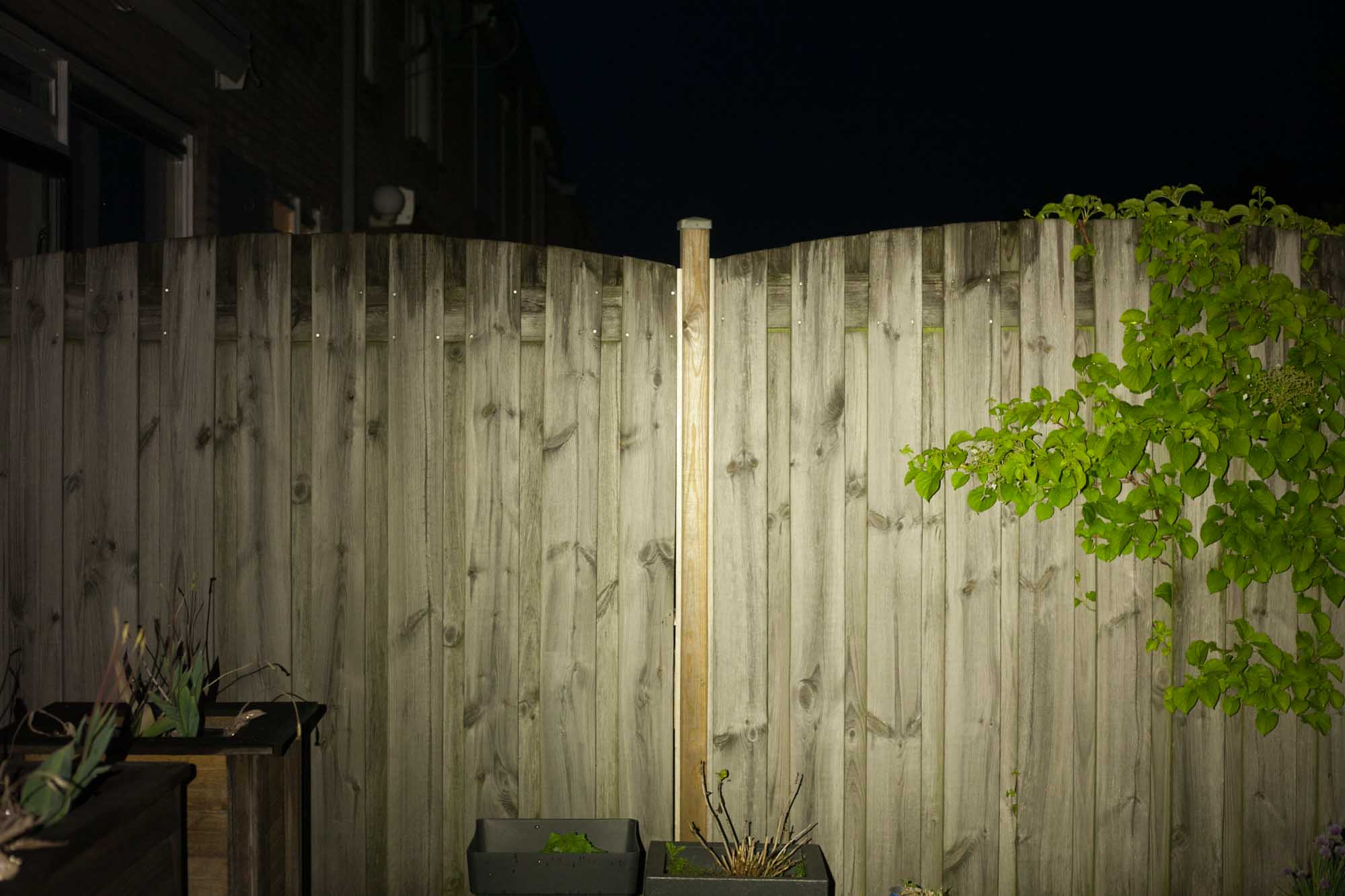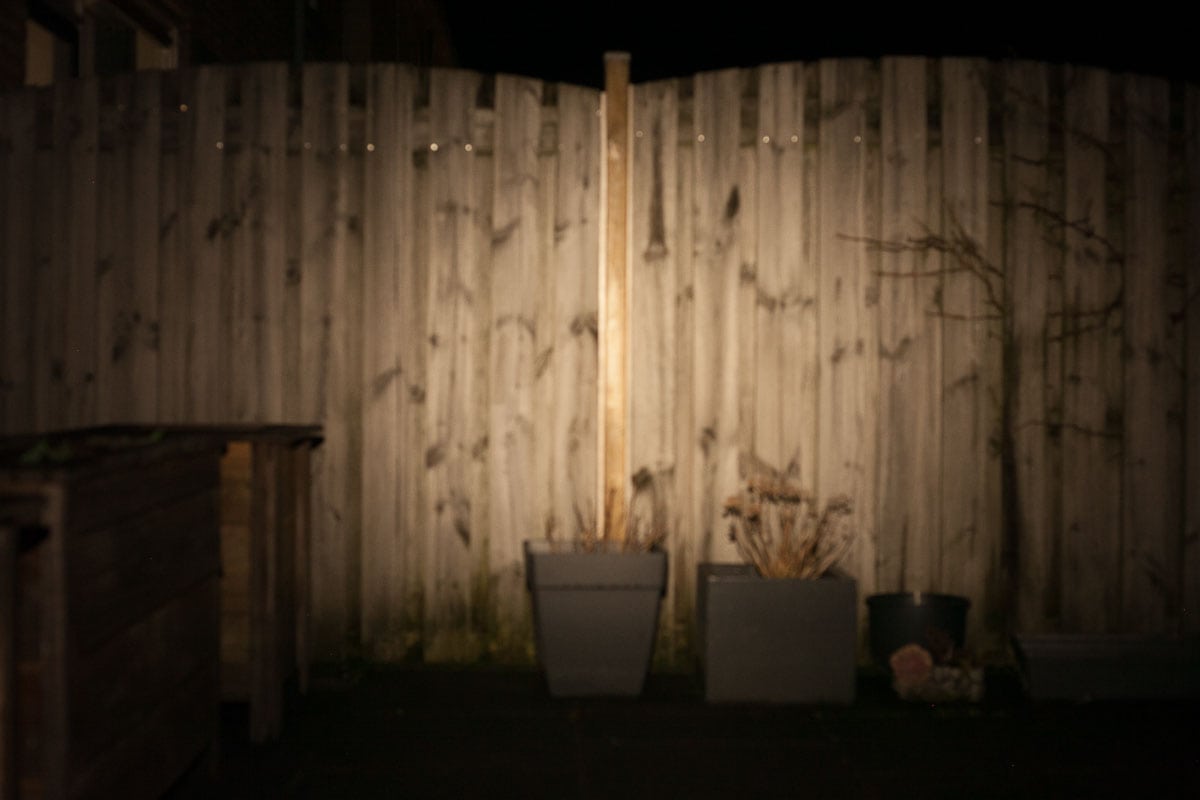1lumen selects and reviews products personally. We may earn affiliate commissions through our links, which help support our testing.
Olight i5R EOS HCRI review: EDC flashlight
Olight i5R EOS HCRI specifications
| Brand/model | Olight i5R EOS HCRI |
|---|---|
| Flashlight category | EDC flashlight |
| LED | ? |
| Max. output | 285 Lumens |
| Max. beam distance | 58 meters |
| Max. beam intensity | 850 cd |
| Battery config. | 1*14500 (2.4V) or AA |
| Onboard charging | None, but the battery has USB-C |
| Modes | 2 |
| Blinkies | N/A |
| Waterproof | IPX8 |
| Review date | October 2022 |
Introduction:
The Olight brand was founded in 2007 and started by building great quality flashlights. But in recent years, they added so many types of lighting products, and even outdoor products, that they elevated from a ‘flashlight brand’ to an ‘outdoor brand’. Their new lineup of products includes knives, hammocks, pry bars, sunglasses and many, many more. That’s also why they opened a new website called obuy.com.
Let’s go back to the review.
This doesn’t look like a new light, correct? That’s right! It looks a lot like its older sibling, the Olight i5T EOS, or the i5R EOS, its direct sibling. The main difference between the i5T and i5R is that the latter uses a 2.4V rechargeable lithium battery but still works on regular AA batteries..
The i5R EOS HCRI is a special edition of the i5R, but then with a high CRI LED. High CRI means that you will be able to see colors more faithfully, in comparison to low CRI LEDs. (CRI stands for Color rendering index).
But does high CRI only have advantages, or also some disadvantages? Let’s find out.
Package quality.
The packaging looks decent, and contains the following:
- Olight i5R EOS HCRI
- Pocket clip (attached)
- 2.4V battery (size 14500, with USB-C port, and 1420 mAh)
- Short USB-A to USB-C charging cable
- Manual
Flashlight in use
The Olight i5R EOS HCRI has only 1 switch, and it’s located at the tail. It’s a forward-clicky switch: half-pressing the switch will give you momentary light. When you repeat the half-pressing, you’ll switch between the 2 modes, low and high. When you fully press the switch, you’ll hear a click, and then your mode is set. If you want to change modes, you have to turn the light off and repeat the half-pressing until you have the other mode selected.
Keep in mind that reverse clicky switches work in a different way. Those will only turn on when you fully press the switch and after you hear the click. The benefit of a reverse clicky switch is that you can change modes, while the flashlight is turned on. You just have to half-press/tap the switch to change modes.
There’s no way you can tail-stand the i5R EOS HCRI, just like the i5T EOS, without help, because of the protruding switch.
In terms of carrying, you can use the pre-attached 2-way pocket clip. It’s attached just below the tailcap, and as the name implies, can either point it upwards or downwards. The clip also has a tiny hole, that you can use to attach a lanyard to. The package, however, didn’t include a lanyard, but there are plenty of them online for relatively cheap. The pocket clip also serves as an anti-roll feature, so it won’t roll off the table.
This type of light is probably best for EDC-ing. Keep it in your pocket and use it when necessary. The output is relatively low, but may be enough for some errands around the house, or even walking the dog. You should just keep in mind that you might run out of battery if you’re using high mode a lot.
Build Quality, and Warranty
Like all Olights, the i5R EOS HCRI is build very well.
The switch is the only part you can unscrew, and when unscrewed you’ll see copper threading. It seems to me that the switch assembly is as heavy as the body+head together.
The battery tube doesn’t have the traditional knurling, but 2 parallel lines going around the body. Please see the images. The head has no knurling and is glued to the battery tube.
Anodization seems to be done very well. And the light is available in blue and black as of now. But I am pretty sure it will also be available in other colors soon.
The pocket clip is black and can be used in both directions, but it doesn’t appear to be extremely strong.
Olight warranty according to their website:
If your Olight product has any defect as the result of the materials or workmanship we want to make it right! Within 30 days of purchase: Return the product to the retailer you purchased it from and they will replace or repair it. Period. Within 5 years of purchase: Return the product to Olight and we will repair or replace it as long as the light is not working because of factory defects. This does not include obvious user wear or extreme damage. After 5 years of purchase: Return the product to Olight and we will repair or replace it. We will assess the fees involved and will let you know once we receive it.
LED, Lens, Bezel, Beam, and Reflector
This is probably the most interesting part of the review, together with the performance section. And that’s mainly because this is a High CRI version of the Olight i5R EOS.
This time, Olight shows the CCT as well as the CRI measurement which is really nice. We’ve reviewed a couple of Olights that also have these numbers printed on the flashlight. The Olight Perun Mini, as well as the i5R Plus come to mind. The CCT and CRI numbers are printed on the bezel, near the edge.
Often times, it’s not too difficult to decipher the LED a flashlight manufacturer used by looking at it through the reflector. But for the i5R EOS it’s a little harder because I have no idea what type of LED this is. It seems to be some kind of Osram?
5000K means it’s neutral.. Kind of perfect neutral in my opinion. If you’d go towards 4000K, white objects aren’t really white anymore, but yellow/orange. With 5000K, you would normally get nice white colors, except if the tint is really off.
I measured with my Opple Light Master III Bluetooth, at about 3 meters, the following. (keep in mind this is an average. If you move the light a little to the left, or right, you get slightly different numbers.
Low mode measured at 1 meter.
- CCT: 4325K
- Ra (CRI): 95.3
- DUV: 0.0046
High mode measured at about 3 meters:
- CCT: 4387K
- Ra (CRI): 94.6
- DUV: 0.0048
If you don’t understand what this all means, no worries. CCT is the color temperature of the light. The lower the number, the warmer. 5000K is about the middle, and neutral white. Olight sells the i5R EOS as being 5000K, but my Opple measurements show it’s much lower than that, at just below 4400K. I wished It would be closer to 5000K though, as that’s more in the territory of my personal favorite CCT.
That means it’s a neutral white beam, but slightly towards yellow if you point it to a white wall/paper.
CRI is clearly above 90, as advertised. So that’s really good.
DUV is a bit positive, which means a little greenish. A negative DUV would be a bit more pinkish.
Keep in mind that these approximate, and can differ 5-10% from measurements with a high-end spectrophotometer.
I also tested PWM (Flicker) and you can see the data below. This was measured at about 1 meter distance for both modes.
Dimensions and size comparison
Dimensions:
| Dimensions Olight i5R HCRI | Millimeters | Inches |
|---|---|---|
| Length | 95.4 mm | 3.757″ |
| Head + body diameter | 17.85 mm | 0.70″ |
Weight:
| Weight Olight i5R HCRI | Weight in grams | Weight in Oz. |
|---|---|---|
| Without battery: | 39.9 grams | 1.41 oz. |
| With Olight battery | 60 grams | 2.12 oz. |
Olight i5R EOS HIGH CRI flashlight comparison
Size compared to other AA flashlights
Group 1, from left to right: Lumintop EDC05, Lumintop Tool AA 2.0, Lumintop EDC AA, Convoy T2, Manker E05, Reylight Pineapple v4, Olight i5r EOS, Olight i5R EOS HCRI, noname stainless steel AA, Fenix E12
Group 2: Olight i5R EOS HCRI, Olight i5T Plus.
Group 3: Olight i5R EOS, Olight i5R EOS HCRI
Driver & User Interface:
The i5R EOS HCRI has a very simple UI with only 2 modes and a forward clicky switch (that is protruding). It uses a 2.4V battery or a 1.2/1.5V battery.
Available modes:
- Low, High
From OFF:
- Half-press: momentary On
- Single-click: Low
- Tapping: change between low and high mode
From ON:
- Single-click: Off
Shortcuts:
- There are no shortcuts. The first mode is always Low
Mode memory:
- No, it will always start in Low
Blinky modes menu:
- No
Low battery warning:
- No
Lock-out mode:
- No, just turn the light off.
PWM:
- Not visible by eye.
Batteries & Charging
The included battery is called Olight ORBC-145C14. This is a 2.4V lithium-ion battery with a USB-C port for charging. The charge current is roughly 0.34A (or 340 mA) and its capacity is 1420mAh. During charge, there is a red light, which turns green when it is finished charging. Charging took me 3 hours and 20 minutes with the included cable.
Note: I didn’t make a mistake, this really provides 2.4V. This is not a typical 4.2V 14500 battery!!! The battery itself says you shouldn’t use it inside any other device or charge it with any other device. You have to charge it via a USB-C cable!
Besides this special battery, you can also use Alkaline (not recommended) and rechargeable NiMH batteries, like the Eneloop AA’s.
Performance test
Lumen measurements:
The output measurements in this review are based on my homemade integrating spheres, each equipped with an Extech SDL400 Lux Meter. For consistency and accuracy, a calibration light (Convoy S2+ with 249lm and a Convoy S2+ with 261lm) is measured prior to each set of lumen measurements.
For high-output lights, one of the lux meters uses an ND camera filter to prevent the lux meter to max out. This is either the Kenko PRO1D ND16 up till about 80,000 lumens or Gobe ND32 for anything above.
All of my readings were taken from a fully-charged Olight ORBC-145C14, a rechargeable Eneloop AA, and disposable Duracell AA.
The measurements were taken manually at turn on and 30 seconds. The 10-minute numbers are taken from the runtime test.
| Mode | Specs | Turn on | 30 seconds | 10 minutes |
|---|---|---|---|---|
| 14500-Low | 12lm | 11 lm | 11.01 lm | 11 lm |
| 14500-High | 285lm | 262 lm | 260 lm | 121 lm |
| Eneloop-Low | ? | 11 lm | 11 lm | 11 lm |
| Eneloop-High | ? | 169 lm | 158 lm | 126 lm |
| Duracell-High | ? | 138 lm | 125 lm | – |
I only tested lumens in High mode with the Duracell battery, without runtime, or low mode measurements.
Parasitic drain:
- There shouldn’t be any with a mechanical switch
Olight i5R EOS HCRI battery life and runtime graphs
The runtime tests were done in the 50cm home made integrating sphere, combined with the Extech SDL400 data logging Lux Meter.
| Mode | Specified | Measured runtime (ANSI FL1) | Time till shut off |
|---|---|---|---|
| 14500-Low | 37h | 37h 09min | 37h 09min |
| 14500-High | 10 min + 170min (3h) | 3h 40min | 3h 40min |
| Eneloop-High | – | 2h 08min | 2h 55min |
| Eneloop Low | – | 26h 22min | 26h 42min |
After the output drop, the output of the lithium battery and Eneloop are almost indistinguishable. The graph shows a slight edge towards the Eneloop, but you wouldn’t be able to notice the difference in person. The Olight battery runs longer.
ANSI FL1 standards: The runtime is measured until the light drops to 10% of its initial output (30 seconds after turning on). This does not mean that the flashlight is not usable anymore. The last column shows how long the light actually works till it shuts off. If there is a + symbol, it means that the test was stopped at that particular point, but the light was actually still running. This happens on certain occasions, with certain drivers, firmware, or batteries.
Olight i5R EOS vs i5R EOS HCRI
Here’s the comparison graph between the original i5R EOS and the i5r EOS HCRI in high mode. As you can see, the HCRI mode has a lower output than the i5R, but runs just a tad longer.
Olight i5R EOS HCRI peak beam intensity and beam distance measurements
Measurements were taken indoors with a Hagner E4-X Lux Meter at 5 meters, and lux meter set to 0.1. Measured after 30 seconds.
| Mode | Specified | Candela measured | Meters | Yards |
|---|---|---|---|---|
| Low | – | 40cd | 13 | 14 |
| High | 850 cd | 905 cd | 60 | 66 |
In terms of beam intensity, it performed a bit better than specced.
Extra info: Peak beam distance according to ANSI FL1 standards: The calculated value of distance in meters at which the flashlight produces a light intensity of 0.25 lux. (0.25 lux is about the brightness of a full moon shining on an object).
Beamshots
For the following beamshots I used a Canon EOS 5D Mk2 and a 50mm lens. manual settings: ISO1600, 1/4sec , F4, 5000K. The shed is about 65 meters / 71 yards away.
The wall of the shed is 5 meters, and the fence 4 meters. The camera was set to 1/30 F4, 5000K, ISO1600.
Compared to the following flashlights:
- Olight i5R EOS
- Olight i5R EOS HCRI
- Olight i3T Plus (2AAA)
- Fenix E12 v2 (AA)
- Reylight Pineapple Mini (AAA)
- Reylight Pineapple (AA)
Disclaimer: This flashlight was sent to me for review at no cost by Olight. I have not been paid to review, nor have I been holding back on problems or defects.
Final Verdict
Pros
- Simple UI with 2 modes
- Comes with a rechargeable battery with USB port
- 2-way pocket clip included
- Works also with AA batteries
- High CRI
Cons
- Might miss a really Low mode?
- Less output than its non high-CRI sibling
Explanation on star ratings:
1: Avoid: my phone flashlight would be a better choice – 2: Poor: significant defect or issues; almost unusable – 3: Average: some defects or issues; but still usable 4: Good: recommended (minor issues) – 5: Great: highly recommended
5 stars: ★★★★★
It’s nice to see that Olight starts to include High CRI LEDs in more and more of their flashlights. The i5R comes as a ready-to-go package, including a rechargeable battery and USB-C charging cable. And if you run out of battery, just pop in a rechargeable NiMH battery or Alkaline (for emergencies).
For EDC it’s a great light, and I like the simple 2 way mode configuration. But some people might miss a moon mode.
Olight i5R EOS HCRI discount code
Use our exclusive 1lumen discount code to get an extra 10% off anything you order at Olightstore.com (USA). Coupon code: 1lumen
1lumen selects and reviews products personally. We may earn affiliate commissions through our links, which help support our testing.


